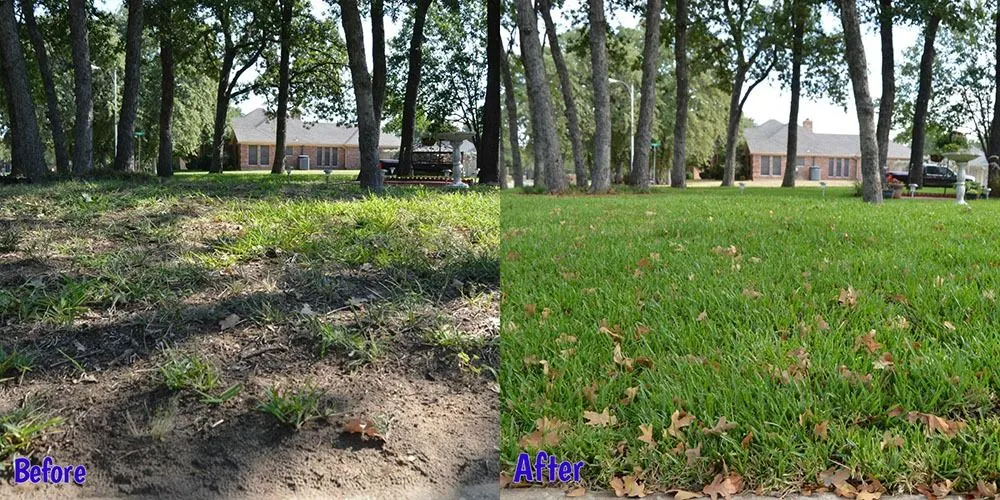North Texas is a pretty tough climate for many different types of grasses. They need to be able to withstand brutal heat and hours of bright sunlight during our extensive warm-season each year, but they also need to be able to survive multiple nights with sub-freezing temperatures. As a result, some of the most popular types of grass used around the area are those that go dormant in order to survive our harsh winter months. When grass goes dormant, it turns a shade of brown that looks awfully similar to grass that is diseased or dying. This makes it difficult to tell if your grass is just naturally hibernating or if you might be facing a more serious issue.
While we strongly recommend having your lawn looked at by an experienced pro, there are a few things you can do to determine your lawn’s health during this pivotal season of the year. Here are a few tips for telling the difference between a dormant and a dying lawn.
Water Your Lawn
Lawns go dormant in order to focus their energy and resources on the processes needed to survive in an inhospitable climate. Rather than using their energy to produce strong, green blades of grass, most grasses will instead focus their energy on keeping their crowns and roots alive so the grass can regrow again in the spring. However, you can trick your lawn into coming out of a dormant state by simply giving it a good amount of water. Turn on your sprinklers and keep the soil moist for a few days during a period where freezing temperatures are not in the forecast (you don’t want to freeze your lawn, after all). If your lawn starts to turn green again, then it’s simply hibernating for the winter. If the lawn doesn’t respond to the water, then your grass might be dead or dying.
Bear in mind, however, that this test may not work during a spell of cold weather. It’s generally best to wait for a period of several days with warmer conditions to try this test, as your lawn may not come back if temperatures are hovering just above freezing.
Look For Patches
When lawns go dormant, they tend to go dormant all at once. In other words, your entire lawn will turn brown with almost uniform timing. If you notice that certain patches tend to go brown before others, then you may have a more serious issue. Take a few minutes to do a quick scan of your lawn and look for where your lawn might be going brown and where it is not. If you notice smaller patches of brown grass amidst areas of green, then your lawn probably needs further treatment.
Test Your Lawn’s Roots
Dormant grass is not dead grass, and therefore it will continue to act as though it were alive when you pull or walk on it even in its dormant state. To test this, find a patch of grass you are unsure of and try to pull out a chunk of it. Dormant grass will still be somewhat difficult to remove, as its roots will be deep and healthy. Dying or dead grass will come out of the ground with ease, as the blade and roots are dried up and will simply fall apart under even the slightest pressure.
Caring for a Dormant Lawn
A dormant lawn is generally pretty self-sustaining and doesn’t require a lot of help. By simply making a few adjustments to your maintenance, you can give your lawn all of the help it needs to roar back to life when the weather warms again in the spring.
- Leave your lawn long. It may be tempting to cut your lawn short so it stays down for the entirety of autumn and winter, but this isn’t good for your lawn. Longer blades reduce moisture loss through evaporation and make it easier for your grass to survive. On your final mow of autumn, don’t be afraid to set your mow height much taller.
- Minimize foot traffic. The less energy your lawn has to put into recovering from foot traffic and heavy use during winter months, the stronger it will come back in the spring.
- Avoid fertilizing and weed treatment. Fertilizing your lawn encourages new growth, and new growth takes a ton of energy and resources that your lawn simply doesn’t have to spare during cold seasons. Weed treatments also generally require an active and thriving lawn in order to be effective and can kill your lawn if you apply them at the wrong time.
Need help keeping your lawn green and thriving? Call Purple Care at (817) 880-6052 to learn more about our great lawn care solutions.




Comments (0)
Thanks for your comment!
Thanks for your feedback! Your comments have been successfully submitted! Please note, all comments require admin approval prior to display.
Error submitting comment!
There is a problem with your comment, please see below and try again.